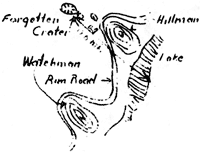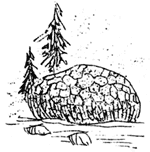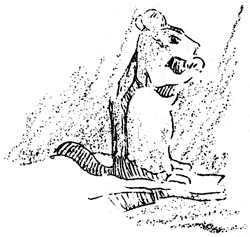Forgotten Crater
By Ranger D. LeC. Evans
To the geologist, that area traversed by the Rim Road presents a multitude of interesting features, all worthy of considerable study. Mazama Rock and the canyon at its base possibly deserves first place; the Hillman Pinnacles, Devil’s Backbone, Llao Rock, Cottage Rocks, and precipitous drop below Cloud Cap appeal to the inquisitive mind of the student of physiography; lastly, U-shaped valleys; masses of fill, polished and grooved rocks, are a temptation to the individual who is glacier conscious.
Possibly because of the major distractions, a very interesting feature has not been described or forgotten as the case may be. It is the purpose of this short sketch to briefly describe it and its importance. Additional work is essential before the newest of cinder cones can be described with any detail.
Located four tenths of a mile west of Hillman Peak, this crater can be seen as one rounds the north side of the Watchman. A flat hill, capped with red, it terminates the ridge that runs down from the Hillman Peak in a westerly direction.
This volcanic outlet consists of two craters. The main crater has an approximate diameter of 300 feet and a depth of about 75 feet, and a small subsiding crater to the east of the main outlets has a 50 foot diameter and only a slight depth.
Preliminary observations might be tabulated as follows:
1. The cone displays two types of cinder material, black and red. The black occurs at the base, particularly on the north side. The cone of red cinders has been erected stop the black, and there is an abrupt steepening in slope as one enters the red cinder cone.
2. Two types of lava were observed. The earliest is a gray, glassy flow rock which is perchance the equivalent of the Basic Andesite of Wizard Island. The latest is a rock showing excellent flow structure and is Dacitic in character, although it might be a Rhyolite when examined in thin section. This same rock without flow structure plugs the old outlet.
3. The cinders make up the north and east sides of the cone, the flow rocks form the south side and the western portion is open. Thus, the shape is that of a horse shoe.
Crater Lake National Park has been known for its adnate cones, its other smaller volcanic outlets existing as satellites about the base of an older and greater volcano. Red cone, 2.4 miles northwest of the water’s edge has always been considered the nearest. This cone (shall we call it Forgotten Crater) is by far the closest to the Lake area, being about eight tenths of a mile northwest of the Rim.
The Park area has always boasted of a simplicity of rock types. The write believed that this cone presents something that is not Andesite, Dacite or Basalt.
In conclusion, the case with which this point can be reached makes it quite attractive. Many people cannot make the more strenuous trips – to Wizard Island, Red Cone and Crater Peak, to investigate the signs of our most recent volcanic action. A short ten minute walk from the saddle behind Hillman Peak enables people to see a real cinder cone, contemporaneous in time, I believe, with that action which erected Wizard Island.
The Rejected Loaf
By Ranger Albert E. Long
Near a bridle trail about one mile southwest of the Cafeteria below the Rim of Crater lake is a large queer ovate boulder-like mass of lava covered by a crackled crusty surface. Indeed it looks very much like a huge loaf of bread that some giantress had left in the oven so long that the surface burned to a black crackled crust.
A geologist would at once proclaim it to be a huge volcanic bomb. A mass of viscid lava that had been hurled into the air during some explosive eruption of a one time active volcano. As this giant globule of molten lava whirled upward and through the atmosphere it became roughly spherical, under the strains of contraction generated by the cooling of the surface. The now hardened mass, nine feet in diameter and about eleven feet long, fell on the side of the volcano where it now rests. However, it may have been carried to the point where it has been found by a mountain glacier that existed on the slopes of the volcano in a past age.
There by the trailside it has lain for ages to be found by man. Some of these men call it a volcanic bomb, while others look upon it and are convinced that it must have been burned, and then tossed out the chimney by an indignant Vulcan who thought it was not fit to eat.
In Memoriam
By Ranger Naturalist E. L. Clark
Those of you who have visited Crater Lake National Park and have been a guest at the Lodge will remember little Oscar, the king of the golden mantled squirrels. Those who have not met Oscar personally may recall the picture postcard of a little sophisticated squirrel sitting on its haunches while eating a peanut that has just been offered by a friend. Oscar for the past two years has been the chief host at the Lodge, extending to all visitors a happy but wistful greeting. This spring he was sitting on the snow bank at the doorstep waiting for the early visitors to call. He prided himself in being able to tell a nut farther than any other squirrel. Being a privileged character, he was permitted to maintain both his private entrances into the hotel, one being near the grand fireplace where it was always so warm and cozy, and the other being near the postoffice window.
Many happy hours he spent on the knees of special friends, eating peanuts to his little heart’s content. His social register for the season included such friends as Captain Steel of the U. S. S. Saratoga, and Tom French, the famous football official of the Pacific Coast. It is rumored that the latter devised several reasons for extending his visit to Crater Lake, but the real reason was to feed the little monarch peanuts. In this he was duly rewarded when Oscar took 33 peanuts in succession.
These little friends in our national parks know no fear. They learn to trust everyone, even those who are leading a dog on a leash. While basking in the warm sunshine on the front steps of the Lodge, our little Oscar was suddenly seized. He felt severe pains rush through his tiny body, then he was shaken and everything became dark. Death had come fast. he never realized what had happened. Friends who witnessed the tragedy tell of a dog that rushed down upon the unknowing and unexpecting little monarch, driving the life from the little body with one vicious crunch of his powerful jaws. The dog had been carelessly tied to the wheel of an automobile.
In ceremonies befitting the occasion the remains of the golden mantled squirrel, Oscar, were cremated in the fireplace that he had learned to love.
Friends, help us protect our wild animal life.
***previous*** — ***next***




